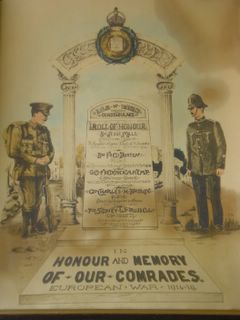Name
Fred Burton, Newport
Biography
Bombardier 20602 Fred Burton, Royal Garrison Artillery
CWGC record ...
Fred Burton is commemorated on the Isle of Wight Constabulary Memorial at Newport Police Station.
Further information
 |
20602 Fred Burton was born in Doncaster and enlisted at Rotherham, joining the Royal Garrison Artillery (RGA). After his period of service he left the Army and joined the Isle of Wight Constabulary. At the outbreak of war, together with other reservists, he was recalled to the colours.
In September 1914 he joined a large group of other artillerymen from the Southern Coastal Division RGA who were being assembled for a brief holding period at the Portsdown Forts. In early October the whole group was sent by train to Woolwich to join one of the many new heavy artillery units being formed; Fred Burton was one of those assigned to 122nd Heavy Battery (HB) and he was quickly made an Acting Bombardier.
There was a desperate need for heavy artillery on the Continent and the Battery was equipped with obsolete weapons of Boer War vintage, the 4.7 inch gun. Most of the men were coastal gunners and a lengthy period of training took place to learn new skills of handling their guns in the field and especially the art of managing the huge cart horses, which pulled the guns and wagon - few men would have known the basic skills of riding, let alone how to care for these essential beasts.
The Battery went to France in early March 1915 and were soon in action at Armentieres. But, by mid-April, they had moved just to the East of Ypres, in Flanders, and were deployed in a forward position. This was just to the South of the section of the front where, on the 22nd April, the Germans launched the first gas attack of the War. The men of 122nd HB soon found themselves in the thick of the action and, over the following two days played a vital part in halting the onrushing attack - at a critical phase there were no friendly infantry between the guns and the enemy. Fred Burton was a member of the Observation Party section with the important, and dangerous, role of maintaining communications between the guns, observation post and Brigade Headquarters.
On the 24th April the situation had become so grave that, by early evening, it was decided to withdraw the Battery to fresh positions on the other side of the City of Ypres; the horses were harnessed to the guns and, covered by the guns of their sister battery, the 122nd galloped out of immediate danger. However, the road back via the village of St Jean and the North of Ypres itself, was under steady, accurate and extremely heavy shellfire. Houses on both sides of the route were blazing and, with darkness falling, great care was needed to guide terrified horses through acrid fumes, around piles of debris and avoid the difficult to spot holes in the road. At Salvation Corner, in Ypres itself, the road was almost entirely blocked by a huge still-smoking crater made by a 17 inch shell.
It was perhaps a miracle that casualties were not greater but, towards the rear of the long winding column of horses, guns, limbers and wagons, Fred Burton was killed in the shell fire. Two other gunners were wounded, three horses were killed and another, the Major's, wounded.
The location of his actual grave has been lost, presumably destroyed during later shelling, but the name of Acting Bombardier Fred Burton is amongst those commemorated on the Menin Gate at Ypres. His is on Panel 9, situated in the central arch of the gate.
Information provided by : Alan Jones, who also writes :
Burton was the first man of the Battery to have been killed in action (another had been killed in a bizarre accident as they left the barracks at Woolwich for France). At the time of his death the Brigade's Aid Post was at Potijze and he may have been buried there in one of the three little cemeteries but I actually suspect he was buried at Ypres Town Cemetery Extension - this is just a hunch based on the fact that other known graves of that period for both the 122nd and the sister battery (123rd) were all buried there.
Four other members of the 122nd killed a little later on the 8th May are also listed on the Menin Gate but I also suspect they are in the Extension.
|
|
|
|
---------------------------------
Page last updated : 6 May 2008
|

